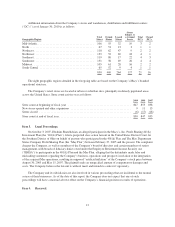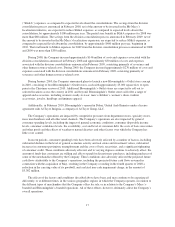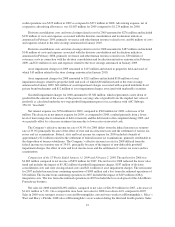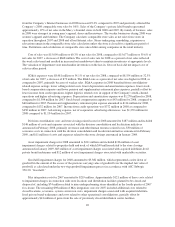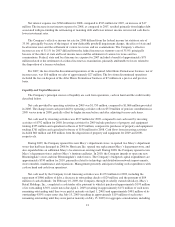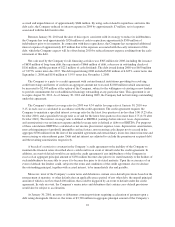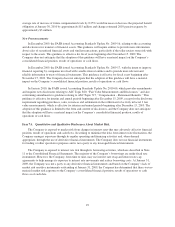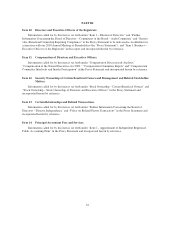Macy's 2009 Annual Report Download - page 28
Download and view the complete annual report
Please find page 28 of the 2009 Macy's annual report below. You can navigate through the pages in the report by either clicking on the pages listed below, or by using the keyword search tool below to find specific information within the annual report.accrued and unpaid interest, of approximately $686 million. By using cash on hand to repurchase and retire this
debt early, the Company reduced its interest expense in 2009 by approximately $7 million, net of expenses
associated with the debt tender offer.
Between January 30, 2010 and the date of this report, consistent with its strategy to reduce its indebtedness,
the Company has used approximately $526 million of cash to repurchase approximately $500 million of
indebtedness prior to its maturity. In connection with these repurchases, the Company has recognized additional
interest expense of approximately $27 million due to the expenses associated with the early retirement of this
debt, which the Company expects will be offset during 2010 by reduced interest expense resulting from the early
retirement of this debt.
Net cash used by the Company for all financing activities was $365 million for 2008, including the issuance
of $650 million of long-term debt, the repayment of $666 million of debt, a decrease in outstanding checks of
$116 million, and the payment of $221 million of cash dividends. The debt issued during 2008 was $650 million
of 7.875% senior notes due 2015. The debt repaid during 2008 included $500 million of 6.625% senior notes due
September 1, 2008 and $150 million of 5.95% notes due November 1, 2008.
The Company is a party to a credit agreement with certain financial institutions providing for revolving
credit borrowings and letters of credit in an aggregate amount not to exceed $2,000 million (which amount may
be increased to $2,500 million at the option of the Company, subject to the willingness of existing or new lenders
to provide commitments for such additional financing) outstanding at any particular time. This agreement is set
to expire August 30, 2012. As of January 30, 2010 and during 2009, the Company had no borrowings outstanding
under this agreement.
The Company’s interest coverage ratio for 2009 was 4.54 and its leverage ratio at January 30, 2010 was
3.15, in each case as calculated in accordance with the credit agreement. The credit agreement requires the
Company to maintain a specified interest coverage ratio for the latest four quarters of no less than 3.00 (3.25 after
October 2010) and a specified leverage ratio as of and for the latest four quarters of no more than 4.75 (4.50 after
October 2010). The interest coverage ratio is defined as EBITDA (earnings before interest, taxes, depreciation
and amortization) over net interest expense and the leverage ratio is defined as debt over EBITDA. For purposes
of these calculations EBITDA is calculated as net income plus interest expense, taxes, depreciation, amortization,
non-cash impairment of goodwill, intangibles and real estate, non-recurring cash charges not to exceed in the
aggregate $500 million from the date of the amended agreement and extraordinary losses less interest income and
non-recurring or extraordinary gains. Debt and net interest are adjusted to exclude the premium on acquired debt
and the resulting amortization, respectively.
A breach of a restrictive covenant in the Company’s credit agreement or the inability of the Company to
maintain the financial ratios described above could result in an event of default under the credit agreement. In
addition, an event of default would occur under the credit agreement if any indebtedness of the Company in
excess of an aggregate principal amount of $150 million becomes due prior to its stated maturity or the holders of
such indebtedness become able to cause it to become due prior to its stated maturity. Upon the occurrence of an
event of default, the lenders could, subject to the terms and conditions of the credit agreement, elect to declare
the outstanding principal, together with accrued interest, to be immediately due and payable.
Moreover, most of the Company’s senior notes and debentures contain cross-default provisions based on the
non-payment at maturity, or other default after an applicable grace period, of any other debt, the unpaid principal
amount of which is not less than $100 million, that could be triggered by an event of default under the credit
agreement. In such an event, the Company’s senior notes and debentures that contain cross-default provisions
would also be subject to acceleration.
At January 30, 2010, no notes or debentures contain provisions requiring acceleration of payment upon a
debt rating downgrade. However, the terms of $3,700 million in aggregate principal amount of the Company’s
22


